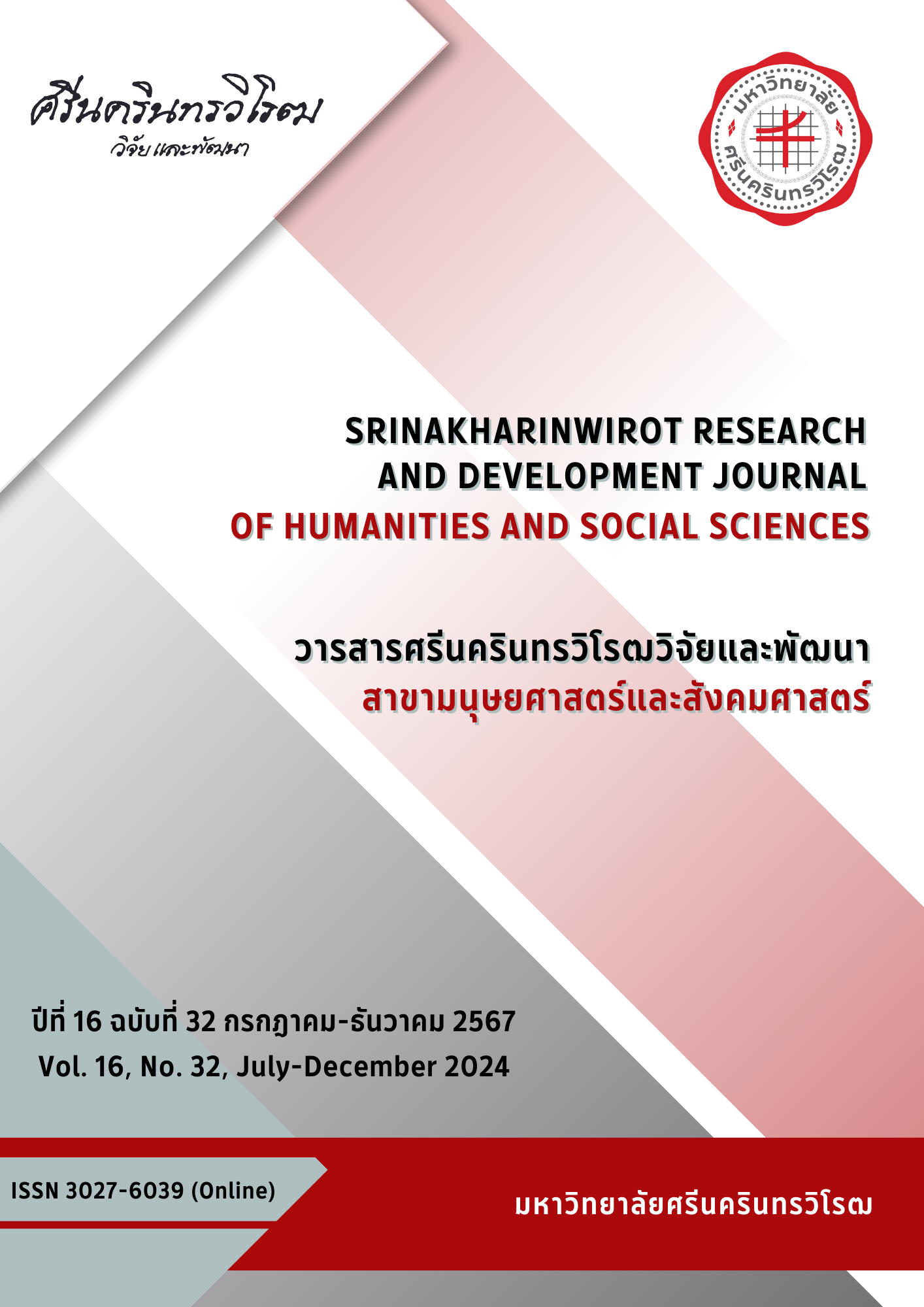DEVELOPMENTAL GUIDELINES FOR RELIGIOUS TOURISM, BETONG SUB-DISTRICT, YALA PROVINCE
Keywords:
Guidelines, Development, Religious Tourism, Betong Sub-DistrictAbstract
This study is qualitative research. It aims to study religious tourist attractions and study developmental guidelines for religious tourism in Betong Sub-district, Yala Province. Phenomenology was used, and data was collected from documents and fieldwork by observation, in-depth interviews as well as group discussion. Key informants were 6 tourism officials, 6 private entrepreneurs, 6 community leaders, 5 tourists, and 5 of those who were related to religious tourism, a total of 28 key informants. The result revealed that religious tourist attractions in Betong Sub-district, Yala Province was famous for tourists and can be connected to religious tourism route in the future. It was comprised of Wat Phothisatto Chaomae Kuan Im, Wat Phuttha Thiwat, and Betong Sub-district Foundation. Each attraction contained unique historical narratives and religious tourism activities such as celebration of Wat Phothisatto Chaomae Kuan Im, candlelight procession, fortune teller and lottery teller. The developmental guidelines for religious tourism in Betong Sub-district, Yala Province consisted of 6 suggestions which could be grouped to form the core of religious tourism development in 4 dimensions 1) Planning such as capability of tourism program; 2) Management such as capability of access to the activities; 3) Supervision such as services of tourist attractions and facilities; and 4) Coordination such as attractions. Consequently, governmental organizations should lead for the coordination and empowerment of synergy of working together as well as aware of the value of each religious tourist attraction. Finally, these guidelines would result in the future strengthening of the economic and social tourism community of Betong.
Downloads
References
กองเศรษฐกิจการท่องเที่ยวและกีฬา. (2565). รายงานผลข้อมูลตามตัวชี้วัดตามแผนแม่บทภายใต้ยุทธศาสตร์ชาติ ประเด็นการท่องเที่ยว 2561. กรุงเทพฯ: สำนักงานปลัดกระทรวงการท่องเที่ยวและกีฬา.
การท่องเที่ยวแห่งประเทศไทย. (2565). แนวทางการจัดการและส่งเสริมการท่องเที่ยว. กรุงเทพฯ: การท่องเที่ยวแห่งประเทศไทย.
สำนักนายกรัฐมนตรี. (2566). แผนยุทธศาสตร์ชาติ 20 ปี (2561-2580). กรุงเทพฯ: สำนักพิมพ์คณะรัฐมนตรีและราชกิจจานุเบกษา.
จีรนันต์ ไชยงามนอกซ์. (2559). ปัจจัยที่มีผลต่อพฤติกรรมการท่องเที่ยวทางพระพุุทธศาสนา. เชียงราย: สำนักพิมพ์มหาวิทยาลัยราชภัฏเชียงราย.
เทศบาลเมืองเบตง. (2565). รายงานสถิติการท่องเที่ยว. ยะลา: กองยุทธศาสตร์และงบประมาณ.
กระทรวงการท่องเที่ยวและกีฬา. (2565). ยุทธศาสตร์การท่องเที่ยว พ.ศ. 2564-2565. กรุงเทพฯ: สำนักนโยบายและแผน.
อัยยรัช อาภาศิลป์. (2563). แนวทางการจัดการการท่องเที่ยวเชิงศาสนาสำหรับนักท่องเที่ยวชาวไทยในพุทธมณฑล ประจำจังหวัดสุพรรณบุรี [วิทยานิพนธ์ปริญญามหาบัณฑิต ไม่ได้ตีพิมพ์]. สถาบันบัณฑิตพัฒนบริหารศาสตร์.
ศุภลักษณ์ อัครางกูล. (2555). พฤติกรรมนักท่องเที่ยว. ขอนแก่น: โรงพิมพ์คลังนานาวิทยา.
กรมการท่องเที่ยว. (2560). แผนยุทธศาสตร์การพัฒนาแหล่งท่องเที่ยวของประเทศไทย พ.ศ. 2560-2564. กรุงเทพฯ: บริษัท พีดับบลิว ปริ้นติ้ง จำกัด.
Fayol, H. (1984). General and industrial management. London: Pitman.
Koontz, H., and Weihrich, H. (2010). Essentials of management: An international perspective. India: McGraw Hill.
ชนัญ วงษ์วิภาค. (2558). การท่องเที่ยววัฒนธรรม: ภาพสะท้อนจากของที่ระลึก. กรุงเทพฯ: คณะโบราณคดี มหาวิทยาลัยศิลปากร.
Pike, S. (2017). Destination positioning and temporality: Tracking relative strengths and weaknesses over time. Journal of Hospitality and Tourism Management, 31, 126-133.
ชาญโชติ ชมพูนุท. (2565). แนวทางการบริหารจัดการการท่องเที่ยวแห่งชาติ. สืบค้นเมื่อ 25 เมษายน 2566, จาก http://www.thaiihdc.org/web/index.php
วรรณา ศิลปอาชา. (2558). ความรู้เบื้องต้นเกี่ยวกับการจัดการทรัพยากรการท่องเที่ยว. นนทบุรี: มหาวิทยาลัยสุโขทัยธรรมาธิราช.
ประพัทธ์ชัย ไชยนอก. (2554). แนวทางการพัฒนาการท่องเที่ยวเชิงวัฒนธรรม: กรณีศึกษาบ้านด่านซ้าย อำเภอด่านซ้าย จังหวัดเลย [วิทยานิพนธ์ปริญญามหาบัณฑิต ไม่ได้ตีพิมพ์]. มหาวิทยาลัยราชภัฏเลย.
พยอม ธรรมบุตร. (2562). แนวทางพัฒนาการท่องเที่ยวเชิงสร้างสรรค์บนพื้นฐานอัตลักษณ์และวิถีไทย แบบบูรณาการอย่างยั่งยืนในเขตบางกอกน้อย กรุงเทพมหานคร. วารสารวิชาการ มหาวิทยาลัยราชภัฏศรีสะเกษ, 13(3), 65-75.
สุชาดา รักเกื้อ. (2560). แนวทางพัฒนาการส่งเสริมการท่องเที่ยวเชิงวัฒนธรรมของเทศบาลตำบลนครชุม อำเภอเมืองกำแพงเพชร จังหวัดกำแพงเพชร. ใน การประชุมวิชาการระดับชาติ ครั้งที่ 4, สถาบันวิจัย มหาวิทยาลัยราชภัฏกำแพงเพชร.
เทิดชาย ช่วยบำรุง. (2554). 9 ปี และก้าวต่อไปของการวิจัยท่องเที่ยวไทย. กรุงเทพฯ: สำนักงานคณะกรรมการส่งเสริมวิทยาศาสตร์ วิจัยและนวัตกรรม.
Dickman, C. R. (2021). Ecological consequences of Australia's “Black Summer” bushfires: Managing for recovery. Integrated Environmental Assessment and Management, 17(6), 1162-1167.
Downloads
Published
How to Cite
Issue
Section
License
Copyright (c) 2024 Srinakharinwirot Research and Development Journal of Humanities and Social Sciences

This work is licensed under a Creative Commons Attribution-NonCommercial-NoDerivatives 4.0 International License.
Srinakharinwirot Research and Development Journal of Humanities and Social Sciences is licensed Under a Creative Commons Attribution-NonCommercial-NoDerivs 4.0 International (CC-BY-NC-ND 4.0) License, Unless Otherwise Stated. Please Read Journal Policies Page for More Information on Open Access, Copyright and Permissions.



